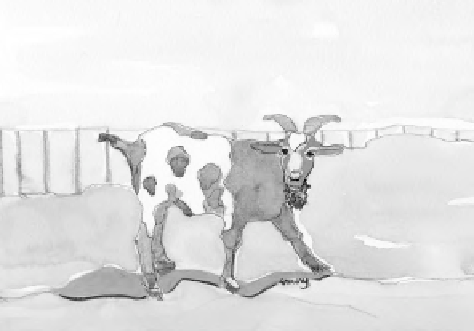Agriculture Reference
In-Depth Information
Figure 2.6
Myotonic (Meat Goat). For color
detail, see Appendix A.
Figure 2.7
British Alpine (Dairy Goat). For color
detail, see Appendix A.
muscular and meaty, and has great potential for cross-
breeding by crossing myotonic bucks with new improved
breeds such as Boer and Kiko. The fainting trait is reces-
sive, so it is not expressed in crossbreeds (OSU, 2004).
This involuntary muscle reaction is reported to increase
meat tenderness. See Figure 2.6 .
and Burns, 1983). Higher reproductive rates and lower
generation intervals are of economic importance for dairy
goats. Most prominent dairy goat breeds are listed in this
chapter: and where available, breed standards are listed.
Alpine
The Alpine breed originated in Switzerland. Alpines are
excellent milkers with well-shaped large udders. Many
composite breeds have Alpine ancestry.
The French Alpine breed is descended from Swiss
Alpine goats of the Alps. These goats were selected for
their uniformity, large size, and high milk production.
They have a larger size than the other Swiss breeds. No
distinct color pattern has been established; color may range
from pure white through shades of fawn, gray, and brown
to black. Both sexes have short hair. The males usually
have long hairs along the spine. The adult bucks weigh
about 77 kg (170 lb) with a height of 85 - 100 cm (34 - 40 in.)
at the withers. The does are about 61 kg (134 lb) in weight
and 75 cm (34 in.) at the withers. They may be either
horned or polled. Except for white, all colors are accept-
able, but the most common color is chamoisee. Ears are
erect and hair is short. They have high milk production and
are adapted to most climates (Briggs and Briggs, 1980).
The British Alpine breed has both horned and polled
animals. The breed is a medium to heavy milker. The
wither height is 95 cm (38 in.) for adult males and 83 cm
(33 in.) for females. The Swiss Alpine was imported into
Great Britain in 1903. The breed was recognized in 1921,
and its herdbook was established in 1925. This breed is
ideally suited for temperate climates. See Figure 2.7.
West African Long - Legged
This breed resembles the West African Dwarf goats except
that they are larger in size, and their horns are long and
twisted (Mason, 1981). They also are known as Sahelian
or Sudan goats, and Fulani. Local names in Mali include
Gorane, Niafounke, and Nioro. The breed is found in
northern Africa spreading between Chad and Senegal, in
the tropical forest, and in thick desert areas. This breed is
used for meat and milk purposes. Their faces are either
straight or slightly convex, and their ears are short. The
coat colors vary from white, black, and brown to pied.
CHARACTERISTICS OF DAIRY
GOAT BREEDS
Dairy goats have been selected primarily for productivity
in terms of milk quantity and milk-fat percent, as well as
effi ciency of production and longevity. Morphological
traits closely related to milk production include large body
capacity and angularity. Composition of milk is an impor-
tant criterion for cheese making. The kidding interval is
another selection criterion. A longer kidding interval is a
desirable trait in temperate climates where there is limited
demand for goat meat, while the opposite is true for the
tropical countries where goat meat is popular (Devendra








